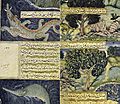Baburnama facts for kids
The Bāburnāma (pronounced Bah-bur-NAH-ma) is a special book written by Ẓahīr-ud-Dīn Muhammad Bābur. He lived from 1483 to 1530. This book is his personal story, like a diary or a journal. Babur was a very important person because he started the Mughal Empire in India. He was also a descendant of Timur, a famous conqueror.
The book's name means "History of Babur" or "Letters of Babur." Sometimes, it's also called Tuzk-e Babri. It's one of the first true autobiographies in the Islamic world.
Contents
What is the Bāburnāma?
The Bāburnāma is a collection of Babur's memories and thoughts. He wrote about his life, his adventures, and the places he visited. It's like reading his own words about what happened to him.
Babur's Life and Adventures
Babur wrote about his journey from a young prince to a powerful emperor. He described his battles, his travels, and the challenges he faced. He also shared his feelings and observations about the world around him.
Why is this book important?
This book is very important for understanding history. It gives us a direct look into the life of a great ruler. It also tells us about the culture, geography, and animals of the time. Babur wrote about everything he saw, from plants to people.
The Languages of the Bāburnāma
Babur wrote his memoirs in the Chagatai language. This language was spoken by his people, the Timurids, in a region called Andijan. Babur himself called this language "Turki," which means "Turkic."
Translations Over Time
Later, during the time of Emperor Akbar, Babur's grandson, the book was translated. A courtier named Abdul Rahīm translated it into Persian. Persian was the main language used in the Mughal court for writing. This translation happened around 1589-1590.
After that, the Bāburnāma was translated into many other languages. Most of these translations happened in the 1800s and later. This allowed many more people around the world to read Babur's story.
What can you find in the book?
The Bāburnāma is full of interesting details. Babur wrote about the animals he saw in India, like peacocks and different kinds of deer. He also described the landscapes, from mountains to rivers.
Battles and Sieges
Babur was a military leader, so his book describes many battles. He wrote about how his army fought and how they captured forts. For example, he described the siege of Isfarah.
Daily Life and Observations
Beyond battles, Babur also wrote about everyday life. He mentioned visiting temples and riding rafts. He even wrote about hunting rhinoceroses with his son, Humayun. These details help us imagine what life was like back then.
Images for kids
-
Illustrations in the Baburnama regarding the fauna of India.
-
Victoria and Albert Museum: Babur and a group of men including his son, Humayun, the next emperor were encamped near Bagram and were told that a rhinoceros had been seen nearby. As Humayun had never seen one before, they rushed to find it.
-
Babur and his army emerge from the Khwaja Didar Fort, British Museum
-
National Museum, New Delhi, Squirrels, a Peacock and Peahen, Demoiselle Cranes and Fishes
-
Foray to Kohat, Walters
See also
 In Spanish: Baburnama para niños
In Spanish: Baburnama para niños













